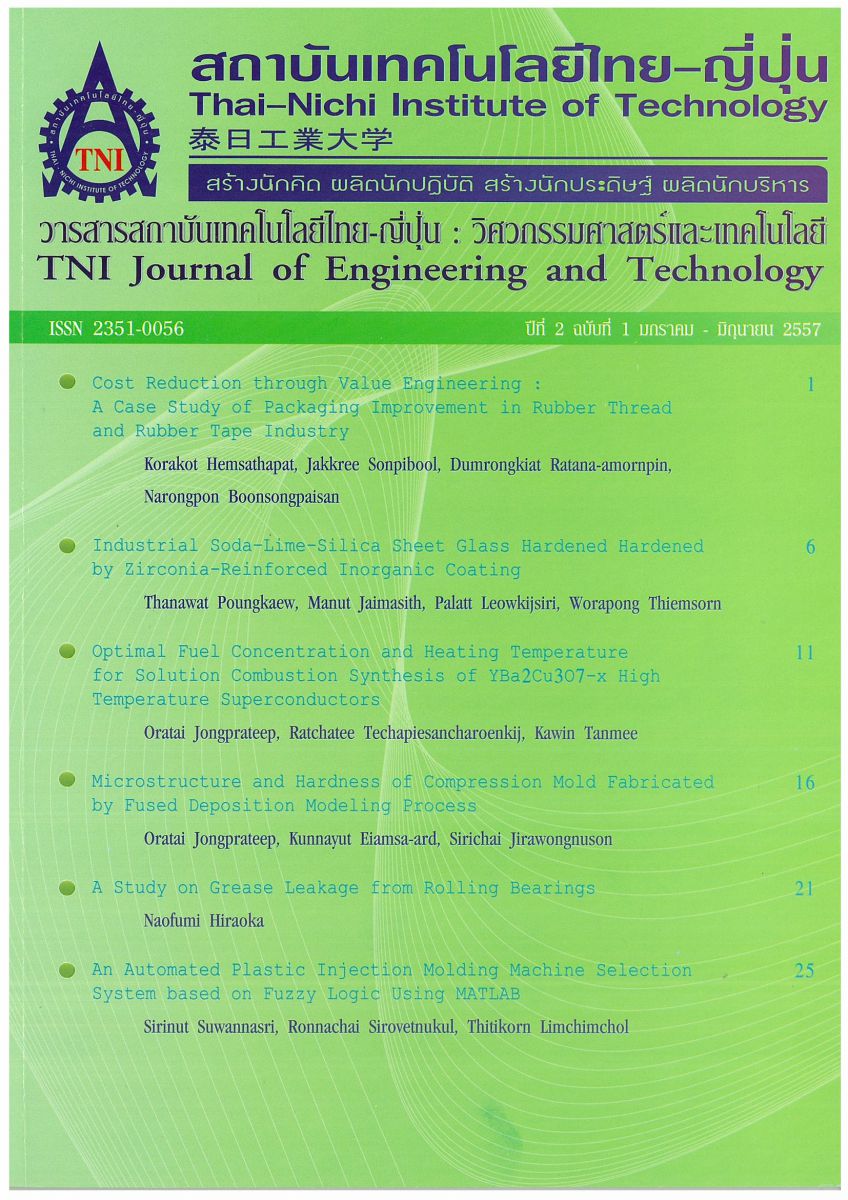Microstructure and Hardness of Compression Mold Fabricated by Fused Deposition Modeling Process
Main Article Content
Abstract
Various rapid prototyping techniques have been developed for the growing industrial demands, which includes fabrication of compression molds for rubber products. The fused deposition modeling (FDM) process is one of the rapid prototyping techniques capable of producing molds with reduced cost and fabrication time. The FDM process employed in this study involves deposition of steel wires onto steel substrates, using MIG/MAG welding machine equipped with CNC milling machine. The steel wires were deposited layer by layer from bottom to top and milled for surface finish. Microstructure and hardness of the mold were examined using scanning electron microscope (SEM) and Rockwell hardness test. Results from microstructural analysis revealed that there was no appearance of macroscopic pore or crack in the substrates, the deposited wires and the interfaces between substrates and wires. Only micro or submicro-sized pores were observed. Average grain size of the substrate, the deposited wire and the interface areas were 26.1, 11.1 and 9.5 micrometers, while hardness of the same regions were 73.1, 70.8 and 77.5 HRB, respectively. Absence of macroscopic pore or crack as well as comparable hardness for all areas indicated that the deposition process was well controlled.
Article Details
Article Accepting Policy
The editorial board of Thai-Nichi Institute of Technology is pleased to receive articles from lecturers and experts in the fields of engineering and technology written in Thai or English. The academic work submitted for publication must not be published in any other publication before and must not be under consideration of other journal submissions. Therefore, those interested in participating in the dissemination of work and knowledge can submit their article to the editorial board for further submission to the screening committee to consider publishing in the journal. The articles that can be published include solely research articles. Interested persons can prepare their articles by reviewing recommendations for article authors.
Copyright infringement is solely the responsibility of the author(s) of the article. Articles that have been published must be screened and reviewed for quality from qualified experts approved by the editorial board.
The text that appears within each article published in this research journal is a personal opinion of each author, nothing related to Thai-Nichi Institute of Technology, and other faculty members in the institution in any way. Responsibilities and accuracy for the content of each article are owned by each author. If there is any mistake, each author will be responsible for his/her own article(s).
The editorial board reserves the right not to bring any content, views or comments of articles in the Journal of Thai-Nichi Institute of Technology to publish before receiving permission from the authorized author(s) in writing. The published work is the copyright of the Journal of Thai-Nichi Institute of Technology.
References
S. Liu, A. Pope, and R. Daemen, “Welding consumables and weldability” in Intl. Workshop on Underwater Welding of Marine Structures, 1994, pp. 321–350.
E. Pessoa, A. Bracarense, E. Zica , S. Liu, and F. Perez-Guerrero, “Porosity variation along multipass underwater wet welds and its influence on mechanical properties,” J. Mater. Process. Tech., vol. 179 pp. 239–243, 2006.
R. Kacar, and K. Kokemli, “Effect of controlled atmosphere on the mig-mag arc weldment properties,” Mater. Des., vol. 26, pp.508–516, 2005.
S. Kou. Welding metallurgy, New York: Willey Inter Science, 2002.
E. Yaldiz, “Inclusion formation and effect of inclusion in weld metal,” M.Sc. thesis, Marmara Universitesi Fen Bilimleri Enstitusu, Istanbul, Turkey, 1990.
D. Rybicki, “Process Specification for Automatic and Machine Arc Welding of Steel and Nickel Alloy Hardware.” Lyndon B. Johnson Space Center, Houston, TX, NASA Tech. Rep. 2006.
J. Blackburn, “High quality laser welding of titanium alloys,” in European Titanium Conference, 2009
Y. Shi, D. Chen, Y. Lei, and X. Li, “HAZ microstructure simulation in welding of a ultra fine grain steel,” Comput. Mater. Sci., vol. 31, pp. 379–388, 2004.


